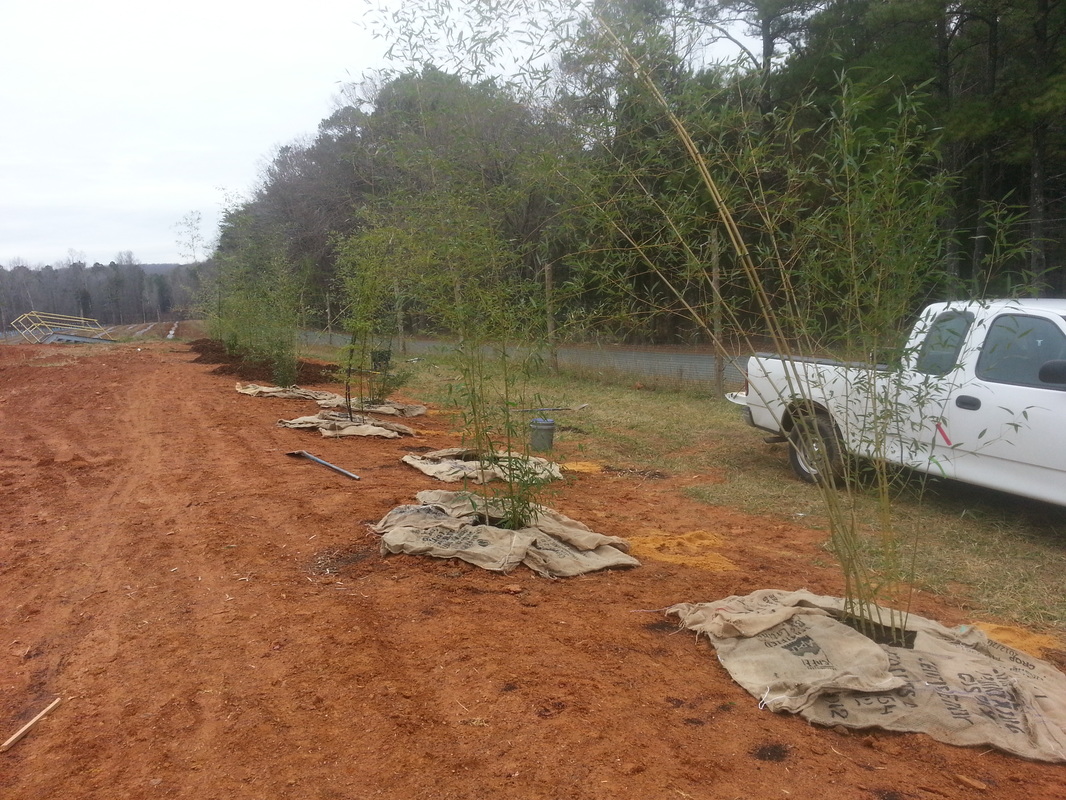|
Burlap coffee bags, often obtained for free, are applied before mulching to help smother potential weeds. Deluxe Method1. The depth of your planting depends on your type of soil and location. Heavy clay soils and/or wet areas will require a shallower hold (IE, planting higher). Sandy/well-draining soils require deeper holes (IE, planting lower). Determine your type of soil and planting area and dig a hole to the appropriate depth. For reference, most of the bamboo we plant in the Piedmont is in heavy clay soil, so we plant about 2/3 into the ground, with about 1/3 sticking up. For sandy soil, or soil on top of a berm or similar situation, we recommend planting at the same depth as the root ball. 2. If the soil is heavy clay, break up the bottom and sides of the hole with a pick or similar tool. 3. Amendments: Mix Azomite/Rock Dust, Rock Phosphate, Greensand, Bonemeal, and Lime at a ratio of 3:3:2:1:1 Sprinkle the number of heaping handfuls listed below at the bottom and sides of the digging hole for the appropriate size plant 3 gallon pot: 1 handful 5 gallon: 1.5 handfuls 7 gallon: 2 handfuls 10 gallon: 3 handfuls 15 gallon: 3 handfuls 25 gallon: 4 handfuls 4. If you think you may have any problems with moles or voles, add in Permatill (also sold as Volebloc) to the bottom and sides of the holes. 5. Take the bamboo out of the pot (or cut the pot off). If it looks root-bound you'll want to gently coax the rhizomes out of their tight circling. It helps to cut some of the feeder roots in order to free up the rhizomes. 6. Apply mycorrhizal fungi to the exposed roots. 7. Place the plant in the bottom of the hole adjusting the base so it has full contact with the soil (no air gaps), is tilted so the bamboo is as vertical as possible, and the top of the rootball is level with the soil level. If the area is prone to be wet, plant a little high, 1"-3" above soil level. 8. Backfill with 50/50 mix of native soil and compost. If the rootball is above ground level, add soil up to the level of the root ball. 9. Compact the backfill moderately with the heal of your foot. 10. Apply fertilizer (organic preferred) and Ironite if necessary. 11. If weeds may be a problem apply around the bamboo a sheet mulch out of newspapers, cardboard, or (preferably) burlap. 12. Mulch liberally in a circle around the bamboo, taking care not to pile the mulch against the base of the culms (in a doughnut shape). 13. Tie and stake tall bamboo if necessary to prevent from blowing over in high winds. 14. Water in well. Barebones Method1. Read instructions above about the difference between clay, loam, and sandy soils to determine planting depth.
2. Dig a hole about 30% wider than the size as the pot 3. If heavy clay, break up the sides and bottom with a pick. 4. If there are circling rhizomes, separate the rhizomes so they'll be able to spread. 5. Set the bamboo flat on the bottom so that it is sitting upright at the right depth and without air gaps. 6. Back fill the sides with a mix of native soil and compost or topsoil. 7. Add soil mix so that it covers the portion of the root ball sticking above the surface (if any). 8. Mulch 9. Water in well.
3 Comments
12/6/2023 09:22:31 pm
It's interesting when you said that proper soil management is important for the best bamboo tree growth. A few nights ago, my wife informed me that she was planning to have bamboo plants in our backyard for a natural living experience and privacy protection. She asked if I had any idea what would be the best bamboo approach. I appreciate this helpful bamboo guide article for the best planning approach. I'll tell her that it will be much better if we consult a trusted bamboo farm that can provide more information about the process.
Reply
Leave a Reply. |
David BenfieldDavid is founder of Brightside Bamboo and dreams of world where bamboo is utilized in helping solve our biggest problems. Archives
May 2024
Categories |

 RSS Feed
RSS Feed